Comparison of sCIM and mCIM for Detection of Carbapenemase-producing Carbapenem-Resistant Enterobacterales in Saraburi Hospital
Keywords:
Carbapenem-resistant Enterobacterales (CRE), carbapenemase, simplified carbapenem inactivation method (sCIM), modified carbapenem inactivation method (mCIM)Abstract
This study aimed to compare the efficacy of phenotypic detection of CPE (carbapenemase-producing Enterobacterales) between simplified carbapenem inactivation method (sCIM) and modified carbapenem inactivation method (mCIM) comparable with genotypic method (multiplex PCR; polymerase chain reaction). The sCIM is based on the mCIM with the improvement of experimental procedures. Instead of 4-hours incubating the meropenem disk in trypticase soy broth medium, the organism was smeared directly onto the imipenem disk in the sCIM. The results revealed that the prevalence of CRE (carbapenem-resistant Enterobacterales) was 1.38%, classified as Klebsiella pneumoniae, Enterobacter cloacae, and Escherichia coli (64.42, 19.23, and 16.35%, respectively). Comparing the results of CPE detection, both methods and multiplex PCR showed 100% concordance with positive results for all 103 strains and negative results for 1 strain. (Cohen’s kappa = 1.0, 95%CI =1.0-1.0). Thus, the sCIM is easy to perform, reducing the step to make it more convenient, cost-effective, and does not require special tools, however, the amount of bacterial load has been carefully considered. Therefore, the sCIM may be suitable for routine use in clinical microbiology laboratories.
Downloads
References
กระทรวงสาธารณสุข กระทรวงเกษตรและสหกรณ์. แผนยุทธศาสตร์การจัดการการดื้อยาต้านจุลชีพประเทศไทย พ.ศ. 2560–2564 [อินเทอร์เน็ต]. 2559 [เข้าถึงเมื่อ 13 เมษายน 2563]. เข้าถึงได้จาก: http://narst.dmsc.moph.go.th/documentation/AMR%20strategy%202560-2564.pdf
World Health Organization. Global priority list of antibiotic-resistant bacteria to guide research, discovery, and development of new antibiotic [Internet]. 2017 [cited 2021 Apr 8]. Available from: https://www.who.int/medicines/publications/WHO-PPL-Short_Summary_25Feb-ET_NM_WHO.pdf?ua=1
Suay-García B and Pérez-Gracia MT. Present and future of carbapenem-resistant Enterobacterales (CRE) infections. Antibiotics [Internet]. 2019 [cited 2020 May 10]; 8,122-38. Available from: https://www.mdpi.com/2079-6382/8/3/122/htm
Tamma PD, Simner PJ. Phenotypic detection of carbapenemase-producing organisms from clinical isolates. J Clin Microbiol 2018;56(11):e01140-18.doi: 10.1128/JCM.01140-18.
วันทนา ปวีณกิตติพร. การพัฒนาระบบเฝ้าระวังเชื้อดื้อยาระดับชาติและระดับโลก [อินเทอร์เน็ต]. 2559 [เข้าถึงเมื่อ 13 เมษายน 2563]. เข้าถึงได้จาก: http://nih.dmsc.moph.go.th/data/data/59/22_6/3.pdf
Al-Zahrani IA. Routine detection of carbapenem-resistant gram-negative bacilli in clinical
laboratories. Saudi Med J 2018;39(9):861-72.
Nordmann P, Poirel L, Dortet L. Rapid detection of carbapenemase-producing Enterobacterales. Emerg Infect Dis 2012;18(9):1503-7.
Zwaluw Kvd, Haan Ad, Gerlinde N, Bootsma HJ, Neeling A, Schouls LM. The carbapenem inactivation method (CIM), a simple and low-cost alternative for the Carba NP test to assess phenotypic carbapenemase activity in gram-negative rods. PLOS ONE 2015;1-13. doi:10.1371/journal.pone.0123690.
Pierce VM, Simner PJ, Lonsway DR, Roe-Carpenter DE, Johnson JK, Brasso WB, et al. The modified carbapenem inactivation method (mCIM) for phenotypic detection of carbapenemase production among Enterobacterales. J Clin Microbiol 2017;55:2321–33.
Clinical and Laboratory Standard Institute. Performance standards for antimicrobial susceptibility testing; Twenty-seventh information supplement. CLSI document M100-S29. Wayne, PA. 2017.
Jing X, Zhou H, Min X, Zhang X, Yang Q, Du S, et al. The simplified carbapenem inactivation method (sCIM) for simple and accurate detection of carbapenemase-producing gram-negative bacilli. Front Microbiol 2018;9(2391):1-7.
ศิรประภา มินาผล, สุรศักดิ์ แว่นรัมย์, จิราภรณ์ นิลสกุล, มารุตพงศ์ ปัญญา, ภาวนา พนมเขต. ความชุกของแบคทีเรียวงศ์เอ็นเทอโรแบคทีเรียซีอีที่ผลิตเอนไซม์ Carbapenemase ในโรงพยาบาลสรรพสิทธิประสงค์. วารสารเทคนิคการแพทย์และกายภาพบำบัด 2562;31:105-13.
สุกัญญา บัวชุม, ไพโรจน์ โจวตระกูล, สุชาดา วงพระจันทร์. ปัจจัยที่มีความสัมพันธ์กับการติดเชื้อแบคทีเรียกลุ่ม Enterobacterales ที่ดื้อต่อยา Carbapenem: CRE ในผู้ป่วยที่เข้ารับการรักษาในโรงพยาบาลพิจิตร. วารสารวิจัยและวิชาการสาธารณสุขจังหวัดพิจิตร 2563;1:1-9.
Laolerd W, Akeda Y, Preeyanon L, Ratthawongjirakul P, and Santanirand P. Carbapenemase-producing carbapenem-resistant Enterobacterales from Bangkok, Thailand, and their detection by the Carba NP and modified carbapenem inactivation method tests. Microb Drug Resist 2018;24(7):1006-11.
วีวรรณ อาชีวะ. ความชุกของเอนไซม์ดื้อยากลุ่ม Carbapenems ที่แยกได้จากเชื้อดื้อยา Carbapenem-resistant Enterobacterales ในโรงพยาบาลพระปกเกล้า ปี พ.ศ. 2555 - 2556. วารสารศูนย์การศึกษาแพทยศาสตร์คลินิกโรงพยาบาลพระปกเกล้า 2559;33(4):136-7.
Yamada K, Sasaki M, Murakami H, Aoki K, Morita T, Ishii Y. Evaluation of the simplified carbapenem inactivation method as a phenotypic detection method for carbapenemase-producing Enterobacterales. J Microbiol Methods [Internet]. 2021 [cited 2021 Sep 20];1-5. Available from: https://doi.org/10.1016/j.mimet.2021.106273
Downloads
Published
How to Cite
Issue
Section
License
Copyright (c) 2021 HCU Journal

This work is licensed under a Creative Commons Attribution-NonCommercial-NoDerivatives 4.0 International License.
บทความที่ได้รับการตีพิมพ์เป็นลิขสิทธิ์ของวารสารวิทยาศาสตร์สุขภาพและสุขภาวะ
ข้อความที่ปรากฏในบทความแต่ละเรื่องในวารสารวิชาการเล่มนี้เป็นความคิดเห็นส่วนตัวของผู้เขียนแต่ละท่านไม่เกี่ยวข้องกับมหาวิทยาลัยหัวเฉียวเฉลิมพระเกียรติ และคณาจารย์ท่านอื่นๆในมหาวิทยาลัยฯ แต่อย่างใด ความรับผิดชอบองค์ประกอบทั้งหมดของบทความแต่ละเรื่องเป็นของผู้เขียนแต่ละท่าน หากมีความผิดพลาดใดๆ ผู้เขียนแต่ละท่านจะรับผิดชอบบทความของตนเองแต่ผู้เดียว




